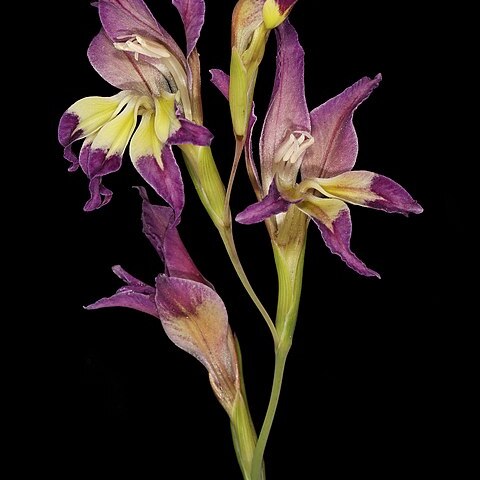Plants 120-350 mm high. Corm conic, 8-14 mm diam.; tunics hard, ± woody, fragmenting irregularly and often claw-like below, orange when young. Stem erect below, flexed outward above sheaths of upper leaves, then weakly inclined, frequently branched. Leaves 5 or 6, lower 3 to 5 basal, reaching to base or shortly exceeding spike, linear, 1.5-4.0(-9.0) mm wide, main veins but not margins lightly raised, cauline leaves shorter, uppermost diverging from stem or sheathing only near base. Spike inclined, flexuose-scalloped, 5-to 8-flowered; bracts pale green, apices sometimes becoming dry, veins transparent, attenuate, outer 20-30(-35) mm long, inner shorter to ± as long, minutely forked. Flowers blue-purple or bright pink, occasionally entirely dull yellow, lower 3 tepals bright yellow in lower 1/2, usually lightly rose-scented; perianth tube obliquely funnel-shaped, 12-17 mm long, lower cylindric part 8-11 mm long; tepals lanceolate, dorsal largest, lightly inclined, 30-37 x 10-16 mm, upper laterals slightly shorter than dorsal, suberect and extending at least partly behind dorsal, curving outward distally, lower 3 tepals united for 3-5 mm, free parts narrowed below into claws 2-4 mm long, deeply channelled, limbs sharply deflexed and pinched together at point of flexure with margins raised into ascending auriculate lobes, 15-22 x 9-11 mm, ± straight. Filaments 11-15 mm long, exserted 5-7 mm from tube; anthers 6-8 mm long, greyish or yellow; pollen yellow. Style arching over stamens, dividing opposite upper 1/3 of anthers, branches 2-3 mm long. Capsules globose, 3-lobed-retuse above, ± 10 mm long. Seeds 5-7 x ± 5 mm, broadly and usually asymmetrically winged with seed body closer to one side.
More
Cormous geophyte, 120-350 mm tall, corm tunics more-or-less woody. Leaves linear to falcate, thicker in the midline, mostly 2-5 mm wide. Flowers in a 5-8-flowered, flexuose spike, bilabiate, purple to pink with yellow markings on the lower tepals, fragrant, perianth tube funnel-shaped, 12-17 mm long, dorsal tepal largest, 30-37 mm long, inclined over stamens, upper lateral tepals curving back, lower tepals pinched and geniculate below, narrow.
Cormous geophyte, 20-60 cm, tunics woody. Leaves linear to falcate. Flowers bilabiate, lower tepals pinched and geniculate below, purple to pink with yellow lower tepals, fragrant.

